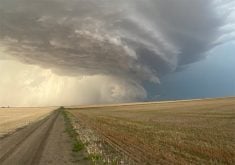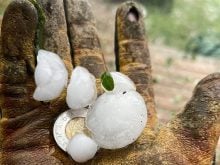A US$91.3-million project to replace the aging St. Mary Diversion Dam is expected to start construction in 2024, strengthening a system relied on by farmers and communities for water in Alberta and Montana, said an official.
Few improvements have been made to the American-controlled dam since it was built circa the First World War, said Tim Romanow, executive director of the Milk River Watershed Council Canada. It provides up to 90 percent of the flow of the Milk River by diverting water from the St. Mary River near Babb, Montana, into a canal system linking the two rivers.
Read Also

Factors that can cause heavy rainfall
There are several factors that can contribute to an extreme rainfall event, the first is atmospheric moisture.
Related stories in this issue:
- Work continues on dream to irrigate eastern Alberta
- Province plans to modernize Alta. irrigation legislation
Romanow was one speaker at the recent annual conference of the Alberta Irrigation Districts Association in Calgary. He said the failure in 2020 of a concrete drop structure forced the canal to shut down that summer, causing the Milk River to dwindle to a trickle.
It underlined the urgency of the need to replace the diversion system’s increasingly decrepit infrastructure, which is occurring during an era of rising concern over climate change and extreme weather, he said during an interview.
“Climate change is active and happening. You don’t even have to look at modelling to recognize the changes in stream flows that are very well recorded since the early ’30s.”
Water is arriving at different times because of changes in the melting of snowpacks in the Rocky Mountains, he said. It is also being affected by large rain events and flash droughts extending from the Milk River area of southern Alberta into the Hi-Line region of northern Montana, he added.
A heat dome and dry conditions caused natural flows in the Milk River to drop to zero on June 18, 2021, said Alain Pietroniro, who is the Schulich Chair in Sustainable Water Systems in a Changing Climate at the University of Calgary. “This is a problem that there’s no water left in the system, and so… they’re going to have to shut down things, and that doesn’t make anybody very happy, right?”
Pietroniro is the Canadian co-chair of the International St. Mary and Milk Rivers Study Board, which is an initiative launched in 2021 by the International Joint Commission. One goal of the four-year study is to achieve long-term resilience in how water in the two rivers is accessed by Canada and the United States.
The allotment of water to each country was set by an order in 1921 at the IJC under the terms of a treaty signed in 1909, with the majority going to the U.S. Although the study isn’t looking at reopening the treaty, it is examining whether there is flexibility to improve access to water under the current arrangement through options such as changes in irrigation procedures, scheduling or infrastructure, said Pietroniro.
The Milk River Joint Board of Control estimated Jan. 23 the total cost of the St. Mary Unit of the Milk River Project will be US$372.7 million. It ranged from the diversion dam to work on the canal, siphons and drop structures.
Romanow said the dam is slated to be funded through the state of Montana and the U.S. federal government. The diversion system is in Montana, diverting water into the north fork of the Milk River.
The river crosses the border into southern Alberta near Whiskey Gap, flowing east for about 280 kilometres before re-entering Montana. About 8,600 acres are under irrigation in the Milk River basin of Alberta, with about 125,000 acres in the Hi-Line of Montana, said Romanow.
The river also provides drinking water for communities ranging from the town of Milk River, Alta., to the city of Havre, Montana. It is also vital for tourism and recreation activities, such as fly fishing, which is a multimillion-dollar industry in Montana, said Romanow.
Despite the importance of the diversion system, investment from the state and irrigation sector in the U.S. hasn’t kept up with the challenges it is facing, he said.
“There’s a big difference between how irrigation infrastructure has been maintained, expanded and invested in Alberta for the last 100 years versus Montana.”
He pointed to a pipeline in the system that is part of an inverted siphon to transport water over a height of land.
“It’s pretty old,” he told the conference. “If anybody’s been on it, you stand on top of it, it shakes like crazy… and so they’re constantly working on patching it and fixing it up.”
The diversion dam has likely outlived its expected lifespan, increasing the chances it will fail if it is not replaced, said Romanow during the interview.
“There have been challenges for the first couple of weeks of the operating season where (there were) significant leaks at the head gates that were causing disruptions in diversion,” he said.
“And also, it’s become really a black hole in terms of loss for bull trout and species at risk of the Swiftcurrent Creek and the St. Mary River proper down in Montana…. There have been electronic fish gates installed over the years that have had questionable success in terms of preventing entrapment.”
Construction of the dam is expected to take place in May 2024, with it becoming fully operational by November 2027, said Romanow.
















